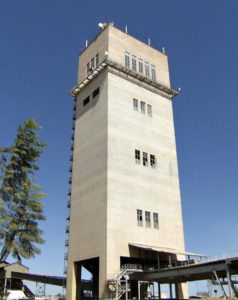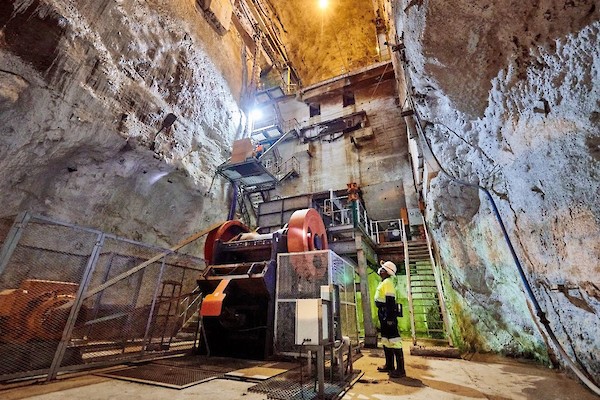Ivanhoe Mines Executive Co-Chair Robert Friedland and President Marna Cloete, together with Alphonse Kaputo Kalubi (Chairman) and Bester-Hilaire Ntambwe Ngoy Kabongo (CEO) of Gécamines, DRC’s state-owned mining company, have announced that Kipushi Holding, an Ivanhoe Mines wholly-owned subsidiary, and Gécamines have signed a new agreement to return the ultra-high-grade Kipushi mine back to commercial production. Kipushi will be the world’s highest-grade major zinc mine, with average grade of 36.4% zinc over the first five years of production. The new agreement sets out the commercial terms that will form the basis of a new Kipushi joint-venture agreement establishing a robust framework for the mutually beneficial operation of the Kipushi Mine for years to come, and is subject to execution of definitive documentation.
Alphonse Kaputo Kalubi commented: “We recently have witnessed Ivanhoe’s outstanding achievements in transforming the Kamoa-Kakula joint venture into a state-of-the-art copper producer applying the highest standards, now a benchmark on the Congolese Copperbelt. Ivanhoe and Gécamines also have now redefined the Kipushi Project in an equitable manner, aligned with the expectations of the Mining Code and those of Gécamines’ sole shareholder, the Congolese State. We are convinced that Kipushi’s new partnership around the Big Zinc will be a benchmark for a successful combination of expertise, resources, a unique asset and a shared desire to create value for stakeholders, the State, shareholders and neighbouring communities. Kipushi, like Kamoa-Kakula, brings new standards, employment opportunities, better health and education infrastructure, and the conditions for the emergence of a dynamic socio-economic fabric around Kipushi. Gécamines, which has operated this mine for a long time, aims, by consolidating its partnership with Ivanhoe, to optimise its contribution to the DRC’s mining sector.”
Bester-Hilaire Ntambwe Ngoy Kabongo added: “We are excited to move our longstanding partnership with Ivanhoe Mines into a new phase that will deliver significant long-term benefits to all parties. Ivanhoe Mines has been a key partner in the Kipushi Project for over a decade and we appreciate their continued commitment to the project. We are confident in Ivanhoe Mines’ technical and financial capabilities to operate the Big Zinc and trust that we can jointly develop the project in a sustainable, responsible and value adding manner for its stakeholders, such as neighbouring communities. Gécamines sees in it the opportunity for an improved exploitation of the Big Zinc, the development of an integrated economic fabric and the imbedding of skills in the Haut-Katanga province.”
“The new agreement with Gécamines is a testament to the great perseverance, ingenuity and patience of Ivanhoe’s team, working alongside our partners in the Democratic Republic of Congo,” Friedland said. “On behalf of Ivanhoe Mines’ Board, I would like to thank our team, led by our President Marna Cloete, who have helped us arrive at this historic day. The outstanding performance by the Kamoa Copper team in delivering the first phases of the Kamoa-Kakula Mine, ahead of schedule and on budget, undoubtedly helped expedite the new agreement, as it showcases our strong development capabilities and industry-leading community initiatives to our partner Gécamines and the Congolese government. The new agreement now allows us to responsibly, efficiently and expeditiously develop Kipushi into an ultra-high-grade zinc producer, with outstanding potential to find more zinc, copper, germanium and silver resources – paving the way to fulfilling its promise of significant, long-lasting, economic and social benefits for the Congolese people. The past few years have been a significant challenge for us all, including the loyal men and women preparing Kipushi’s underground workings for a resumption of production. Together, we have faced the global impact of the COVID-19 pandemic and we have emerged stronger than ever. Now we have a clear line of sight on having our three tier-one, cornerstone mining assets enter commercial production.”

The Kipushi copper-zinc-germanium-silver mine in the DRC Copperbelt is adjacent to the town of Kipushi and approximately 30 km southwest of Lubumbashi. It is located less than one kilometre from the Zambian border. Kipushi has a long and storied history as a major producer of copper and zinc. Built and then operated by Union Minière for 42 years, Kipushi began mining a reported 18% copper deposit from a surface open pit in 1924. It was the world’s richest copper mine at the time. The Kipushi Mine then transitioned to become Africa’s richest underground copper, zinc and germanium mine. State-owned Gécamines gained control of Kipushi in 1967 and operated the mine until 1993, when it was placed on care and maintenance due to a combination of economic and political factors.
Over a span of 69 years, Kipushi produced a total of 6.6 Mt of zinc and 4 Mt of copper from 60 Mt of ore grading 11% zinc and approximately 7% copper. It also produced 278 t of germanium and 12,673 t of lead between 1956 and 1978. There is no formal record of the production of precious metals as the concentrate was shipped to Belgium and the recovery of precious metals remained undisclosed during the colonial era; however, drilling by Ivanhoe Mines has encountered significant silver values within Kipushi’s current zinc- and copper-rich deposits. Germanium is a strategic metal used today in electronic devices, flat-panel display screens, light-emitting diodes, night vision devices, optical fibre, optical lens systems, and solar power arrays.
Most of Kipushi’s historical production was from the Fault Zone, a steeply-dipping ore body rich in copper and zinc that initially was mined as an open pit. The Fault Zone extends to a depth of at least 1,800 m below surface, along the intersection of a fault in carbonaceous dolomites. Before Kipushi was idled, Gécamines discovered the Big Zinc deposit at a depth of approximately 1,250 metres below surface and adjacent to the producing Fault Zone. The Big Zinc Deposit has not been mined and is the initial target for production as outlined in the new feasibility study.
Since acquiring its interest in the Kipushi Mine in 2011, Ivanhoe’s drilling campaigns have upgraded and expanded the mine’s zinc-rich Measured and Indicated Mineral Resources to an estimated 11.78 Mt grading 35.34% zinc, 0.80% copper, 23 g/t silver and 64 g/t germanium, at a 7% zinc cut-off, containing 9.2 billion pounds of zinc, 8.7 Moz of silver and 24.4 Moz of germanium. In addition, Ivanhoe’s drilling expanded Kipushi’s copper-rich Measured and Indicated Mineral Resources to an additional 2.29 Mt at grades of 4.03% copper, 2.85% zinc, 21 g/t silver and 19 g/t germanium, at a 1.5% copper cut-off – containing 144 Mlb of copper.
Ivanhoe Mines also announced the positive findings of an independent, feasibility study for the planned resumption of commercial production at Kipushi. The Kipushi 2022 Feasibility Study (2022 FS) builds on the results of the pre-feasibility study (PFS) published by Ivanhoe Mines in January 2018. The redevelopment of Kipushi is based on a two-year construction timeline, which utilises the significant existing surface and underground infrastructure to allow for substantially lower capital costs than comparable development projects. The estimated pre-production capital cost, including contingency, is $382 million.
The 2022 FS focuses on the mining of Kipushi’s zinc-rich Big Zinc and Southern Zinc zones, with an estimated 11.8 Mt of Measured and Indicated Mineral Resources grading 35.3% zinc. Kipushi’s exceptional zinc grade is more than twice that of the world’s next-highest-grade zinc project, according to Wood Mackenzie, a leading, international industry research and consulting group. The 2022 FS does not include any of the copper-rich mineral resources delineated to date and assumes that revenue is attributable to zinc only, with no by-product credits.
The 2022 FS envisages the recommencement of underground mining operations, and the construction of a new concentrator facility on surface with annual processing capacity of 800,000 t of ore, producing on average 240,000 t of zinc contained in concentrate. Concurrent with the release of the 2022 FS, Ivanhoe is finalising Kipushi’s development and financing plan, together with its partner Gécamines. The Kipushi Mine is operated by Kipushi Corporation (KICO),a joint venture between Ivanhoe Mines wholly owned subsidiary, Kipushi Holding, and Gécamines, the DRC’s state-owned mining company.
Significant progress has been made in recent years to modernise the Kipushi Mine’s underground infrastructure in preparation for the resumption of commercial production, including upgrading a series of vertical mine shafts to various depths, with associated headframes, as well as underground mine excavations and infrastructure. A series of crosscuts and ventilation infrastructure is still in working condition and has been cleared of old materials and equipment to facilitate modern, mechanised mining. The underground infrastructure also includes a series of high-capacity pumps to manage the mine’s water levels, which now are easily maintained at the bottom of the mine.

Shaft 5 is 8 m in diameter and 1,240 m deep, and has been upgraded and re-commissioned. The main personnel and material winder has been upgraded and modernised to meet international industry standards and safety criteria. The Shaft 5 rock-hoisting winder also is fully operational with new rock skips, new head- and tail-ropes, and attachments installed. The two newly manufactured rock conveyances (skips) and the supporting frames (bridles) have been installed in the shaft to facilitate the hoisting of rock from the main ore and waste storage silos feeding rock on the 1,200 m level. In addition, Kipushi recently installed a new Sandvik Rock Processing Solutions underground jaw crusher, which has a crushing capacity of 1,085 t per hour.
Mining at Kipushi has historically been carried out from the surface to a depth of approximately 1,220 m. Shaft 5 (P5) is planned to be the main production shaft with a maximum hoisting capacity of 1.8 Mt/y and provides the primary access to the lower levels of the mine, including the Big Zinc Zone, through the 1,150 m haulage level. Mining will be performed using highly productive mechanised methods and cemented rock fill will be utilised to fill open stopes. Material generated underground will be trucked to the base of the P5 shaft, crushed and hoisted to surface. Personnel and equipment access also are via the P5 shaft. The Big Zinc Zone will be accessed via the existing decline, without significant new development required. As the existing decline already is below the first planned stoping level, it is relatively quick to develop the first zinc stopes for the ramp up of mine production. An optimised mine sequence was developed for the 2022 FS in order to mine the highest-grade portion of the Big Zinc orebody earlier, by accelerating mine development during the plant construction period. As a result, the average grade for the first five years of mining increased from 30.2% in the PFS to 36.4% in the 2022 FS.
Metallurgical testwork conducted during the 2022 FS program demonstrated that the Kipushi flowsheet could be optimised to maximise zinc output by means of a dense media separation (DMS) and mill-float circuit. A bulk sulphide flotation circuit is considered for its simplicity in terms of reagent suite, reagents handling, and cost savings – producing a superior consistent performance when compared to the differential flotation circuit during the PFS phase.











